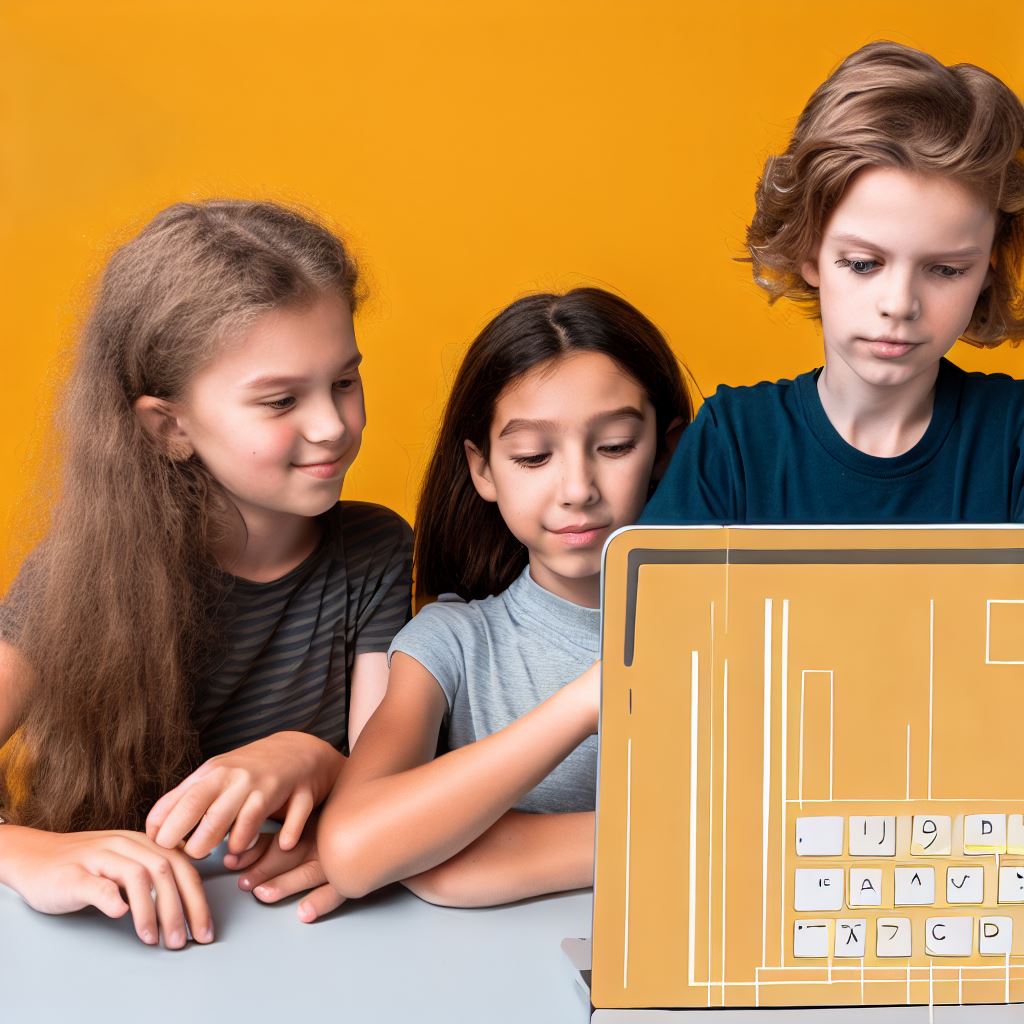Introduction
In the world of coding and creative programming, mastering the intricacies of Scratch’s interface is an indispensable skill.
Efficiently manoeuvring through Scratch’s interface can unlock a world of possibilities for your projects, enabling you to bring your imaginative ideas to life with ease.
In this blog post, we will provide you with an all-encompassing overview of indispensable Scratch interface tips and tricks, enabling you to navigate it with expertise.
Whether you’re a beginner looking to get started or an experienced coder seeking to enhance your skills, these insights will prove invaluable in your journey toward becoming a Scratch maestro.
Let’s dive right in and explore how to unlock the full potential of Scratch’s interface for your upcoming coding adventure with these Scratch interface tips.
Basic Interface Elements
Stage
The stage in Scratch is where all the action happens. It is like a blank canvas where users can create and design their projects.
The purpose of the stage is to provide a visual space for the sprites to interact and for the scripts to run.
Sprites
Sprites are the characters or objects that move, make sounds, and interact with each other on the stage.
They can be imported from the Scratch library or created from scratch. Sprites can be images, drawings, or even text.
Blocks Palette
The Blocks Palette is a collection of blocks or commands that users can use to program their sprites.
These blocks have different categories such as Motion, Looks, Sound, Events, and more.
Each block represents a specific action or function that the sprite can perform.
Scripts Area
The Scripts Area is where users can create and manipulate scripts for their sprites.
It is located below the stage and is divided into blocks that can be dragged and stacked together to form a sequence of instructions.
Users can create scripts to control the movement, appearance, and behavior of their sprites.
Tech Consulting Tailored to Your Coding Journey
Get expert guidance in coding with a personalized consultation. Receive unique, actionable insights delivered in 1-3 business days.
Get StartedStage Monitor
The Stage Monitor displays real-time information about the project, such as the values of variables, the current position of the sprite, or the result of calculations.
It can be used to debug code and monitor the progress of the project.
Navigating the basic interface elements
Tips for navigating the basic interface elements:
- Familiarize yourself with the different elements of the interface. Take some time to explore the stage, sprites, block palette, script area, and stage monitor.
- Use the search bar in the blocks palette to quickly find specific blocks or commands. This can save you time when looking for a certain function or action.
- Drag and drop blocks from the blocks palette into the scripts area to build your scripts. You can connect blocks to create a sequence of actions or use them individually.
- Customize your sprites by changing their appearance or adding new costumes. You can import images, draw your sprites, or use the built-in scratch characters.
- Experiment with different block combinations to create unique and interesting effects. Don’t be afraid to try out new ideas and see how they work together.
- Frequently test your scripts by clicking the green flag on the stage or pressing the “play” button in the scripts area. This enables you to observe code performance and make essential adjustments.
- Use the stage monitor to keep track of variables and their values. This can help you debug your code and better understand how different actions affect your project.
Generally, understanding the basic interface elements in Scratch is essential for creating interactive and engaging projects.
The stage, sprites, block palette, script area, and stage monitor all play a crucial role in building and running Scratch programs.
By familiarizing yourself with these elements and using the tips provided, you can effectively navigate the interface and unleash your creativity in Scratch.
Read: The Evolution of Scratch: From 1.0 to Present
Understanding the Blocks Palette
In Scratch, the Blocks Palette is an essential part of the interface that allows users to create and customize their scripts.
Let’s dive deeper into understanding this useful tool.
Different block categories and their purpose
The Blocks Palette in Scratch is organized into various categories, each serving a specific purpose. These categories include:
- Motion: This category contains blocks that control the movement of sprites on the stage.
- Looks: Here, you’ll find blocks to change the appearance of sprites, such as setting their size or changing costumes.
- Sound: These blocks enable you to add sounds to your project, play music, or control volume.
- Events: This category focuses on triggering scripts based on specific events, like when a button is pressed or when the project starts.
- Control: Blocks in this category allow you to control the flow of your program, with options like loops and conditional statements.
- Sensing: Here, you can find blocks related to sensing inputs from the keyboard, mouse, or other hardware.
- Operators: The operators’ category contains blocks for performing mathematical and logical operations.
- Variables: This category allows you to create and use variables to store and retrieve values.
- List: The list category includes blocks for working with lists, which are useful for storing multiple values.
- Custom: In this category, you can store and organize custom blocks that you create.
Editing and customizing blocks
The Blocks Palette also offers the ability to edit and customize blocks to better suit your needs.
By right-clicking on a block, you can access options such as duplicating, deleting, or even making a block a part of your custom category.
Additionally, you can customize blocks by changing their parameters. For example, you can adjust the angle of rotation in the motion block to control the direction of movement.
Search bar functionality
Scratch provides a search bar within the Blocks Palette that allows you to quickly find specific blocks.
Build Your Vision, Perfectly Tailored
Get a custom-built website or application that matches your vision and needs. Stand out from the crowd with a solution designed just for you—professional, scalable, and seamless.
Get StartedBy typing keywords or phrases related to the block you’re looking for, Scratch will display relevant blocks as you type.
This feature saves you time and makes it easier to locate the blocks you need, especially if you’re not familiar with the category they belong to.
Favorite blocks feature
Another useful capability of the Blocks Palette is the ability to mark blocks as favorites. This feature allows you to create a personalized collection of frequently used blocks for quick and easy access.
To add a block to your favorites, simply right-click on the block and select the “Add to my Blocks” option. These blocks will then appear in the “My Blocks” category for easy retrieval.
Tips to efficiently navigate the Blocks Palette
To navigate the Blocks Palette efficiently, keep the following tips in mind:
- Organize blocks into custom categories to streamline your workflow and make it easier to find specific blocks.
- Use the search bar to quickly locate blocks, even if you’re unsure of their category.
- Take advantage of the favorites feature to access frequently used blocks in a single click.
- Experiment with different blocks and their parameters to explore the full potential of Scratch’s functionalities.
- Regularly explore new blocks or browse existing ones to expand your knowledge and discover new possibilities.
Understanding the Blocks Palette is crucial for building exciting projects in Scratch.
By utilizing its different categories, customization options, and additional features, you can unleash your creativity and create amazing interactive experiences.

Working with Sprites
Adding and Deleting Sprites
When creating a project in Scratch, sprites play a crucial role. They are the characters or objects that users interact with.
Adding a sprite is simple; you can click on the “Choose a Sprite from Library” button and select one of the predefined options.
Alternatively, you can import your images or even draw your sprite using the Scratch editor’s drawing tools.
To delete a sprite, right-click on it in the sprite list or stage area and select “delete.” You can also use the “delete” block in the coding area by dragging it into your scripts.
Modifying a Sprite’s Appearance
To change a sprite’s looks, you can take advantage of Scratch’s various features.
The “Costumes” tab in the sprite editor allows you to add multiple costumes or images to a sprite. You can upload your images or draw new ones using the built-in editor.
To switch between costumes during the program’s execution, use the “switch costume to” block in your scripts. This allows you to animate sprites or create visual effects.
Optimize Your Profile, Get Noticed
Make your resume and LinkedIn stand out to employers with a profile that highlights your technical skills and project experience. Elevate your career with a polished and professional presence.
Get NoticedOrganizing Sprites Using the Sprite List
When working with multiple sprites, keeping track of them becomes essential.
The sprite list on the left-hand side of the Scratch interface helps organize and manage your sprites effectively. Clicking on a sprite in the list makes it active, bringing up its scripts in the coding area.
You can reorder sprites in the list by dragging and dropping them to the desired position. This is especially useful when you want certain sprites to appear in front or behind others on the stage.
Duplicating and Hiding Sprites
Instead of creating new sprites from scratch, you can duplicate existing ones to save time. Right-click on a sprite in the list and choose “duplicate.”
The newly created sprite will have the same appearance and scripts as the original.
You can also hide a sprite using the “hide” block in your scripts. Hidden sprites will not be visible on the stage but will still execute their scripts.
Tips for Managing Sprites Effectively
Here are some helpful tips for managing sprites in Scratch:
- Give your sprites descriptive names: Use meaningful names for your sprites to easily identify them in the sprite list.
- Use different layers: Take advantage of the “send to front” and “send to back” blocks to control the order in which sprites appear on the stage.
- Group related scripts: Organize your scripts by sprite to make them easier to navigate, especially in complex projects.
- Utilize variables: Use variables to store sprite-specific information, such as scores, health, or position.
- Explore custom blocks: Create custom blocks to encapsulate frequently used scripts for a specific sprite, simplifying your code.
Essentially, understanding how to work with sprites is essential for creating engaging projects in Scratch.
Adding, modifying, organizing, duplicating, and hiding sprites are all important skills to master.
By effectively managing your sprites, you can bring your projects to life and enhance the user experience.
Read: Scratch vs ScratchJr: Which is Right for Your Child?
Utilizing the Scripts Area
The scripts area in Scratch is where all the coding magic happens. It allows you to bring your project to life by creating scripts using drag-and-drop programming.
Drag-and-drop programming is an intuitive way of coding that beginners find easy to understand. It involves snapping blocks together to create commands and sequences.
Let’s dive deeper into this concept.
Introduction to Drag-and-Drop programming
In Scratch, you can find various blocks in the scripts area, each representing a specific command. To create a script, you need to drag and drop these blocks onto the scripts area.
The blocks are color-coded and have distinct shapes, making it easier to identify and match them. This visual representation allows you to understand and arrange commands easily.
Snapping blocks together correctly
When creating a script, it’s important to ensure that you snap the blocks together correctly. Each block has connection points that fit into corresponding slots in other blocks.
To create sequences, you simply snap blocks together. For example, if you want to move a character on the screen, you would snap a “move” block onto an “when green flag clicked” block.
Controlling scripts with events and loops
To make your scripts more interactive, you can use events and loops. Events are triggered actions that initiate a script, such as when a key is pressed or a sprite is clicked.
Loops, on the other hand, allow you to repeat a script multiple times. For instance, you can use a “repeat” block to make a character move back and forth on the screen.
Nesting blocks and conditional statements
In Scratch, you can also nest blocks within other blocks. This means you can put a block inside another block to create more complex actions and conditions.
Conditional statements are another powerful feature of Scratch. They allow you to create scripts that behave differently depending on specific conditions, such as “if” or “if-else” statements.
Tips for organizing scripts and troubleshooting errors
As your project grows, it’s important to organize your scripts to maintain clarity and avoid confusion. You can use color-coded blocks or comment blocks to label sections of your script.
When troubleshooting errors, it’s helpful to use the “show blocks” feature. This feature highlights the executed blocks, allowing you to identify which blocks might be causing the error.
Another useful tip is to take advantage of the “debugging mode” in Scratch. This mode allows you to step through your script one block at a time, helping you find and fix errors more efficiently.
The scripts area in Scratch is where the magic of coding happens.
By utilizing drag-and-drop programming and following proper block-snapping techniques, you can create scripts, control events and loops, nest blocks, and use conditional statements effectively.
Remember to keep your scripts organized and use troubleshooting techniques to fix any errors that may arise.
Utilizing these Scratch interface tips and tricks, you’ll swiftly master navigation and craft remarkable projects within no time.
Read: Top 5 Scratch Projects That Went Viral and Why
Customizing the Stage and Using the Stage Monitor
In Scratch, you have the flexibility to customize the appearance of the stage and utilize the stage monitor to enhance your projects.
Let’s delve into how you can maximize these features with Scratch interface tips and tricks.
Changing the stage appearance and backgrounds
One way to personalize your project is by changing the stage’s appearance and background.
You can choose from the wide range of options available in the Scratch library or even upload your images.
Utilizing the backdrop library
The backdrops library in Scratch is a valuable resource that offers a variety of pre-designed backgrounds.
It allows you to create engaging and visually appealing scenes that can enhance the user experience.
Using the stage monitor for variables and messages
Another useful feature is the stage monitor. It allows you to monitor variables and messages in real time, providing you with valuable insights during project development.
By utilizing the stage monitor, you can keep track of important variables such as score, level, or any other custom variables you create.
This feature becomes particularly useful in game development where real-time feedback is crucial.
Using the stage monitor for variables and messages
In addition to monitoring variables, you can also utilize the stage monitor to display messages. This feature enables you to communicate with the user or provide instructions within your project.
Broadcasting messages between sprites
Broadcasting messages between sprites is another powerful function that Scratch offers.
This feature allows sprites to communicate and collaborate, enhancing the interactivity and complexity of your projects.
Tips for utilizing the stage and stage monitor efficiently
When working with the stage and stage monitor, it is essential to utilize them efficiently to optimize your project’s performance. Here are some tips to help you achieve that:
- Limit the number of objects on the stage to reduce the processing load on the system.
- Organize your code blocks effectively to avoid cluttering the stage monitor and make it easier to read and understand.
- Regularly check and debug any code blocks related to the stage monitor to ensure smooth operation.
- When broadcasting messages between sprites, be mindful of the timing and sequence to maintain project coherence.
- Test your project thoroughly to identify any performance issues related to the stage and stage monitor.
Customizing the stage’s appearance and effectively utilizing the stage monitor can greatly enhance your Scratch projects.
By making the most out of these features, you can create engaging, interactive, and visually appealing experiences for your users.
So, don’t hesitate – delve into the possibilities, and unleash your creativity with these Scratch interface tips and tricks.
Advanced Interface Features
Scratch offers various advanced interface features that allow users to customize their projects and collaborate with others.
In this section, we will explore these features in detail, providing tips and tricks for enhancing your Scratch experience.
Using the sprite editor to modify costumes
One key feature that advanced users can take advantage of is the sprite editor.
With this tool, you can modify the appearance of your sprites by adding or editing costumes.
Each costume represents a different look for the sprite, allowing you to create unique characters or objects for your projects.
Importing and exporting sprites and backdrops
Additionally, Scratch enables users to import and export sprites and backdrops.
This means you can bring in external images from your computer or download images from online sources to use in your projects.
Similarly, you can also export your sprites and backdrops to share them with others or use them in different Scratch projects.
Utilizing the sound library
Another exciting feature of Scratch is the sound library.
Here, you can explore a wide range of pre-loaded sound effects and music clips to enhance your projects.
From background music to character dialogues, the sound library provides a variety of options to add audio elements to your Scratch creations.
Collaborative features and sharing projects online
Furthermore, Scratch offers collaborative features that enable users to work together on projects.
You can invite others to join your project and collaborate in real time. This collaborative aspect not only promotes teamwork but also fosters creativity as different perspectives and ideas are brought together.
Sharing projects online is also a significant aspect of Scratch.
The platform allows users to upload their projects to the Scratch website, where they can be viewed and remixed by others.
This sharing feature not only allows you to showcase your creations but also provides an opportunity to learn from and be inspired by the work of others.
Advanced Users’ Essential Scratch Interface Tips
For advanced users looking to take their Scratch experience to the next level, here are some tips:
- Experiment with different costumes and backdrops to create visually appealing projects.
- Use sound effects and music strategically to enhance the overall experience.
- Collaborate with others to learn new techniques and broaden your creative horizons.
- Share your projects with the Scratch community to gain feedback and inspire others.
- Explore advanced programming concepts, such as variables and custom blocks, to create more complex projects.
By utilizing these tips, you can push the boundaries of what you can create in Scratch and unlock the full potential of the platform.
In summary, Scratch’s advanced interface features offer a range of possibilities for users to customize their projects, collaborate with others, and expand their creative horizons.
Whether it’s modifying costumes, importing and exporting sprites and backdrops, utilizing the sound library, or sharing projects online, these features empower users to create unique and engaging experiences.
With the incorporation of Scratch interface tips for advanced users, Scratch transforms into a hub where imagination and innovation converge.
Read: Collaboration and Sharing: The Scratch Online Community
Incorporating Scratch Interface Tips: Additional Tips and Tricks
One of the great advantages of using Scratch is its user-friendly interface. Nevertheless, you can amplify your experience and make it even more enjoyable with some extra Scratch interface tips and tricks.
In this section, we will explore some of these extra features and explain how you can benefit from them.
Utilizing keyboard shortcuts
When it comes to working with Scratch, using keyboard shortcuts can greatly improve your workflow.
These shortcuts allow you to quickly access various commands and perform tasks without relying solely on your mouse.
Learning and implementing them can save you time and make coding more efficient.
Searching for resources and tutorials
In addition to keyboard shortcuts, the Scratch platform offers a wide range of resources and tutorials.
These materials can help you expand your knowledge and skills, providing you with valuable insights and guidance.
Take the time to search for relevant tutorials, example projects, and forums to deepen your understanding of Scratch’s interface.
Staying updated with new Scratch features
It’s crucial to stay updated with new Scratch features.
The development team regularly introduces updates and improvements, which can enhance your coding experience.
By staying informed, you can take advantage of the latest tools and functionalities, ensuring that your projects remain innovative and up to date.
Leveraging the Scratch community for support and ideas
One of the biggest strengths of Scratch is its vibrant and supportive community. Connecting with other Scratch users can greatly benefit your learning journey.
The community offers a welcoming environment where you can share your projects, ask for help, and gain new ideas and inspiration.
Embrace the collaborative nature of Scratch and enjoy being part of a creative community.
Overall, Scratch provides an intuitive and user-friendly interface for coding and creating interactive projects.
By utilizing keyboard shortcuts, exploring online tutorials and resources, staying updated with new features, and engaging with the Scratch community, you can further enhance your experience with the platform.
Don’t hesitate to experiment and push the boundaries of what you can achieve through Scratch’s interface. Enjoy the process, and let your creativity thrive!
Conclusion
This blog post has delved into crucial insights for grasping Scratch’s interface, offering valuable Scratch interface tips for your journey.
It is important to master Scratch’s interface because it is the foundation for creating projects and coding.
By mastering Scratch’s interface, users can unleash their creativity and bring their ideas to life through coding. It provides a user-friendly and interactive platform for beginners to learn coding concepts.
We have also highlighted the importance of experimentation and practice in coding using Scratch. This allows users to explore different possibilities and improve their coding skills.
In conclusion, mastering Scratch’s interface opens up a world of possibilities for users to create their interactive projects and games.
So, we encourage everyone to start experimenting and practising coding with Scratch to unlock their creative potential.




